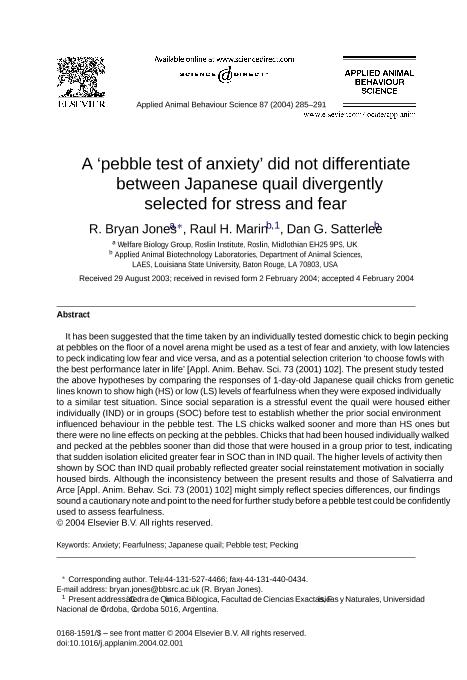Mostrar el registro sencillo del ítem
dc.contributor.author
Jones, R. Bryan
dc.contributor.author
Marin, Raul Hector

dc.contributor.author
Satterlee, Dan G.
dc.date.available
2018-11-14T15:00:34Z
dc.date.issued
2004-08
dc.identifier.citation
Jones, R. Bryan; Marin, Raul Hector; Satterlee, Dan G.; A 'pebble test of anxiety' did not differentiate between Japanese quail divergently selected for stress and fear; Elsevier Science; Applied Animal Behaviour Science; 87; 3-4; 8-2004; 285-291
dc.identifier.issn
0168-1591
dc.identifier.uri
http://hdl.handle.net/11336/64465
dc.description.abstract
It has been suggested that the time taken by an individually tested domestic chick to begin pecking at pebbles on the floor of a novel arena might be used as a test of fear and anxiety, with low latencies to peck indicating low fear and vice versa, and as a potential selection criterion 'to choose fowls with the best performance later in life' [Appl. Anim. Behav. Sci. 73 (2001) 102]. The present study tested the above hypotheses by comparing the responses of 1-day-old Japanese quail chicks from genetic lines known to show high (HS) or low (LS) levels of fearfulness when they were exposed individually to a similar test situation. Since social separation is a stressful event the quail were housed either individually (IND) or in groups (SOC) before test to establish whether the prior social environment influenced behaviour in the pebble test. The LS chicks walked sooner and more than HS ones but there were no line effects on pecking at the pebbles. Chicks that had been housed individually walked and pecked at the pebbles sooner than did those that were housed in a group prior to test, indicating that sudden isolation elicited greater fear in SOC than in IND quail. The higher levels of activity then shown by SOC than IND quail probably reflected greater social reinstatement motivation in socially housed birds. Although the inconsistency between the present results and those of Salvatierra and Arce [Appl. Anim. Behav. Sci. 73 (2001) 102] might simply reflect species differences, our findings sound a cautionary note and point to the need for further study before a pebble test could be confidently used to assess fearfulness. © 2004 Elsevier B.V. All rights reserved.
dc.format
application/pdf
dc.language.iso
eng
dc.publisher
Elsevier Science

dc.rights
info:eu-repo/semantics/openAccess
dc.rights.uri
https://creativecommons.org/licenses/by-nc-sa/2.5/ar/
dc.subject
Anxiety
dc.subject
Fearfulness
dc.subject
Japanese Quail
dc.subject
Pebble Test
dc.subject
Pecking
dc.subject.classification
Otras Ciencias Biológicas

dc.subject.classification
Ciencias Biológicas

dc.subject.classification
CIENCIAS NATURALES Y EXACTAS

dc.title
A 'pebble test of anxiety' did not differentiate between Japanese quail divergently selected for stress and fear
dc.type
info:eu-repo/semantics/article
dc.type
info:ar-repo/semantics/artículo
dc.type
info:eu-repo/semantics/publishedVersion
dc.date.updated
2018-11-12T13:44:50Z
dc.journal.volume
87
dc.journal.number
3-4
dc.journal.pagination
285-291
dc.journal.pais
Países Bajos

dc.journal.ciudad
Amsterdam
dc.description.fil
Fil: Jones, R. Bryan. Roslin Institute; Reino Unido
dc.description.fil
Fil: Marin, Raul Hector. Consejo Nacional de Investigaciones Científicas y Técnicas; Argentina. State University of Louisiana; Estados Unidos
dc.description.fil
Fil: Satterlee, Dan G.. State University of Louisiana; Estados Unidos
dc.journal.title
Applied Animal Behaviour Science

dc.relation.alternativeid
info:eu-repo/semantics/altIdentifier/doi/https://dx.doi.org/10.1016/j.applanim.2004.02.001
dc.relation.alternativeid
info:eu-repo/semantics/altIdentifier/url/https://www.sciencedirect.com/science/article/pii/S0168159104000383
Archivos asociados
